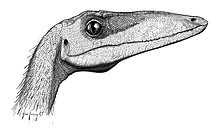Coelophysis
| Coelophysis | ||||||||||||
|---|---|---|---|---|---|---|---|---|---|---|---|---|

Movable model of Coelophysis in the Natural History Museum in London |
||||||||||||
| Temporal occurrence | ||||||||||||
| Upper Triassic ( Norium to Rhaetium ) | ||||||||||||
| 228 to 201.3 million years | ||||||||||||
| Locations | ||||||||||||
| Systematics | ||||||||||||
|
||||||||||||
| Scientific name | ||||||||||||
| Coelophysis | ||||||||||||
| Cope , 1889 | ||||||||||||
| Art | ||||||||||||
|
Coelophysis is a genus previously dinosaur from the group of Theropoda . The particularly lightly built genus weighed an estimated 20 to 30 kilograms with a length of up to about 2.5 meters. Coelophysis lived in the time of the Upper Triassic (Norium to Rhaetium) mainly in the warm, humid coastal forest of today's southwestern part of North America. Only the type species Coelophysis bauri is known.
This species was first described by Edward Drinker Cope in 1889 , after fossils found by David Baldwin eight years earlier. The Coelophysis bauri got its name from Cole's taxidermist Baur. The most important study of this species was carried out by Edwin Harris Colbert in 1947.
anatomy
The bones were, characteristic of theropods, hollow, the limbs long and slender. The skull was narrow and low, the neck longer than the trunk. The dentition consisted of small teeth with piercing tips.
The pelvis (sacrum) was made up of five pairs of ribs , which in the adult animal had grown together with the sacral vertebrae and the uppermost pelvic bone, the low and very long ilium . Another pelvic bone, the pubis , was a narrow, flattened rod that protruded far forward. The two individual bones of the pubic bone, the pubes, were fused together in front along the midline, without forming a shoe-shaped plate, as in many other theropods. The ischial (ischium), the rearmost ( caudal ) part of the pool, was originally built and as for the other early dinosaurs a flat backwards-looking bar.
The tail was very long and counterbalanced the presacral (the part in front of the pelvis) of the body. The shoulder blade was long and narrow, the raven bone (coracoid), another bone of the shoulder girdle , on the other hand a small oval plate. The regression of the collarbone , which is characteristic of theropods, increased the mobility of the arms. The anatomy of the slender forelimbs does not indicate any four-legged locomotion ( quadrupedia ). The three-pronged hand (consisting of three fingers) was designed as a gripping hand . The bones of the lower leg, shin (tibia) and fibula (fibula) were about 20 percent longer than the thigh bone (femur), the tarsus (Tarsus) was greatly reduced.
Way of life
For a long time cannibalism was assumed in this genus, because remains in the intestinal area of large specimens were interpreted as those of young animals. However, a 2006 study found that this interpretation was the result of an imprecise analysis. The fossilized food residues were bones from the ancestors of today's crocodiles ( Crocodylomorpha ).
Two different forms of Coelophysis have been identified, robust and lean. Paleontologists assumed it was both males and females, so it was a case of sex dimorphism .
The best of the thousands of skeletons come from the Petrified Forest member of the Chinle Formation and were found in 1947 by Edwin Colbert on the grounds of the Ghost Ranch in the US state of New Mexico (USA). It is believed that the animals died of thirst at a dried-up water source and were then swept into the Ghost Ranch area by a flash flood.
literature
- Sterling J. Nesbitt, Alan H. Turner, Gregory M. Erickson, Mark A. Norell : Prey choice and cannibalistic behavior in the theropod Coelophysis. In: Biology Letters . Volume 2, No. 4, 2006, pp. 611-614, doi: 10.1098 / rsbl.2006.0524 . PMID 17148302 , PMC 1834007 (free full text).
Web links
- Acquittal for the cannibal dinosaurs. On: Wissenschaft.de from September 20, 2006
Individual evidence
- ^ Gregory S. Paul : The Princeton Field Guide to Dinosaurs. Princeton University Press, Princeton NJ 2010, ISBN 978-0-691-13720-9 , p. 72, (online)
- ^ The Paleobiology Database
- ^ Dougal Dixon : Dinosaurs. Animals of prehistoric times. Translated by Inge Uffelmann. Bassermann, Niedernhausen / Ts. 1992, ISBN 3-8094-0100-5 , p. 28.
- ^ Wighart von Koenigswald (translator): Anatomy and relational relationships of the dinosaurs. In: Robert L. Carroll : Paleontology and Evolution of the Vertebrates. Georg Thieme, Stuttgart et al. 1993, ISBN 3-13-774401-6 , pp. 300-332.
